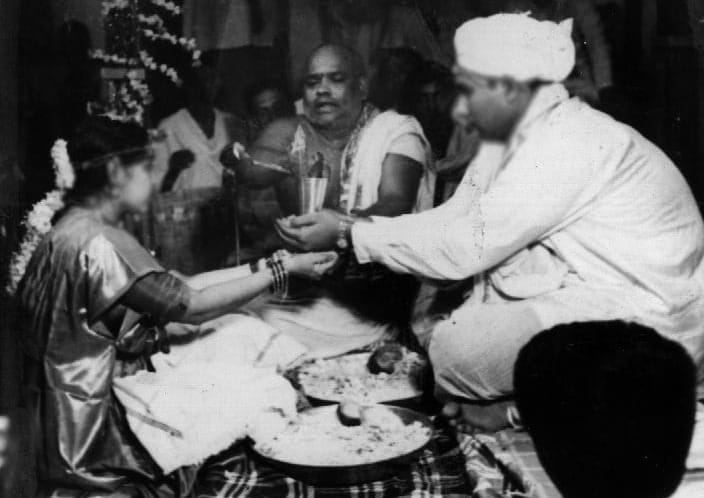Veranda Tales-Nanamma’s asthana pandithudu

Storytelling has been an integral part of my life since childhood. I grew up listening to stories during the hot summer evenings and nights with my cousins. Mothers and grandmothers would gather all of us children for story time. It was usually pitch dark except for a very faint light coming from the flickering candle. Power cuts were as frequent as the hot and humid summer days. We all spread out on a cool concrete floor or bamboo mats on the veranda intently listening to fascinating stories about kings, queens, princes, princesses, and peasants alike. Stories about love, life, families, and people entertained and taught us life skills. These stories transported us to distant worlds, strange yet familiar. Often the same story told by two people sounded different as storytellers added new twists and turns adding their personal style and flair to the stories.
Storytelling wasn’t limited to summer evenings and bedtime. I was surrounded by adults who didn’t pass up an opportunity to share their wisdom using the art of storytelling. These rich vibrant oral traditions include songs, poems, stories, and సామెతలు (Sametalu are proverbs in Telugu). Men and women sing songs as they work in the fields, grinding grains and spices and doing other daily chores at their homes. Stories are often used to teach important life lessons, interpersonal skills, and survival skills. These stories and the time spent listening to them made our lives richer leaving an impression on me. This series is all about reliving those memories as I share these stories.
జగమెరిగిన బ్రాహ్మణునికి జంధ్యమేల? (jagamerigina brahmanuniki jandhyamela?)
I grew up in a Hindu family. We weren't super religious. అమ్మ (Amma is mother in Telugu) or నాన్న (Nanna is father in Telugu) did పూజ (pooja) everyday in the morning. The best part of పూజ (pooja) was the tender flesh and sweet water from the కొబ్బరి కాయ (kobbari kaaya) offered to the gods during పూజ (pooja). కొబ్బరి కాయ (kobbari kaaya) is coconut in Telugu and it is smashed just hard enough on a concrete floor or a small rock during the పూజ (pooja) to be able to drain the water first before breaking it into two halves.
In some houses I lived in, we had a separate పూజ (pooja) room or an area where there was enough space in front of the deities to sit comfortably on a పీట (peeta), a low wooden floor stool in Telugu and still have some room to break the coconut on the floor. In some houses we had our పూజ (pooja) space on a shelf in a built in wall closet with or without doors. We stood in front of it to perform పూజ (pooja). A small rock was used to break the కొబ్బరి కాయ (kobbari kaaya). Then there was మంగళ ఆరతి (mangala aarti), a offering of light lit from burning కర్పూరం (karpuram is camphor in Telugu) in a special aarati plate. The మంగళ ఆరతి (mangala aarti) plate would be circled in front of the deities and then offered to everyone to take in the blessed light. I would warm my hands on the heat from the మంగళ ఆరతి (mangala aarti) and place warm hands on my face.
నానమ్మ (Nanamma is paternal grandmother in Telugu) was big into pooja, rituals, and celebrating festivals. When she stayed at our place, అమ్మ (Amma) and నాన్న (Nanna) left morning పూజ (pooja) in her superior hands. She started పూజ (pooja) after taking bath and I sat next to her cross legged watching her perform పూజ (pooja). I waited eagerly for her to break the coconut at the end of the pooja and drain the coconut water into a small bowl. She offered the coconut halves and the water to the gods followed by మంగళ ఆరతి (mangala aarti). She then dispensed spoonfuls of the now sacred coconut water in our cupped palms as we swallowed the delicious holy coconut water.
సూరయ్య పంతులు (Surayya panthulu) performed పూజ (pooja) at నానమ్మ (Nanamma)’s place. He was summoned immediately whenever a grandchild was born or talk of marriage began for one of her children. He lived in a beach town, Kothapatnam and he would travel to Ongole and other nearby towns to help his clients. He was present at every auspicious occasion officiating and directing పూజ (pooja) for నానమ్మ (Nanamma) and తాతయ్య (Tatayya is grandfather in Telugu). నానమ్మ (Nanamma) and తాతయ్య (Tatayya) sat on their individual పీటలు (peeta)’s side by side facing the gods and సూరయ్య పంతులు (Surayya panthulu) sat at a right angle to both the gods and నానమ్మ (Nanamma) and తాతయ్య (Tatayya). He recited verses in Sanskrit directing నానమ్మ (Nanamma) and తాతయ్య (Tatayya) to perform various rituals of పూజ (pooja). He could recite continuously in his melodious voice while breathing effortlessly through the process. The smell of కుంకం (kumkum), పసుపు (pasupu), అగర్బత్తి (agarbatti), కర్పూరం (karpuram), తమలపాకు (thamalapaaku), and వక్కపొడి (vakkapodi) permeated through the entire room. పసుపు (pasupu) is turmeric in Telugu. అగర్బత్తి (agarbatti is incense in Telugu). వక్కపొడి (vakkapodi) is betel or areca nuts and తమలపాకు (thamalapaaku) is Betel or Piper betle leaf in Telugu.
తాతయ్య (Tatayya) had a good sense of humor. He referred to సూరయ్య పంతులు (Surayya panthulu) as ఆస్థాన పండితుడు (astahana pandithudu). ఆస్థాన పండితుడు (asthana pandithudu) translates to Court Priest in Telugu. He used to ask నానమ్మ (Nanamma), “ఆస్థాన పండితుడిని పిలిపించావా (astahana pandithudini pilipinchava)?” when they talked about upcoming celebrations. The phrase translates to, “Did you summon the ఆస్థాన పండితుడు (astahana pandithudu)?” I was too busy smiling and didn’t pay attention to if నానమ్మ (Nanamma) appreciated his sense of humor or not.
సూరయ్య పంతులు (Surayya panthulu) officiated అమ్మ (Amma) and నాన్న (Nanna)’s wedding ceremony traveling with the wedding party to the bride’s place. Usually bride’s family పూజారి (pujari) would officiate the wedding ceremony. నానమ్మ (Nanamma) had to have సూరయ్య పంతులు (Surayya panthulu) perform the wedding of her firstborn. అమ్మ (Amma)’s parents had to cede to her wishes and accept సూరయ్య పంతులు (Surayya panthulu) officiating the wedding instead.
సూరయ్య పంతులు (Surayya panthulu) wrote my జాతక పత్రం (jataka pathram) when I was born. జాతక పత్రం (jataka pathram) is the birth chart that shows the positions of the Vedic constellations, as well as the positions of the planets, at the moment of person’s birth. Vedic astrological charts are believed to reveal information about a person’s inner self that can act as a guide to the path they choose to travel in their life. When marriages are arranged, prospective bride’s జాతక పత్రం (jataka pathram) is compared with the groom’s to determine compatibility. The families swipe right or left based on the compatibilty. This ensures if the bride is aligned with Venus and the groom isn’t, they can choose to not tie the knot.
సూరయ్య పంతులు (Surayya panthulu) was and still is the embodiment of a proper పూజారి (Pujari) in my head. He wore రుద్రాక్షమాల (rudraksha mala) around his neck and జంధ్య (jandhyam) across his body. రుద్రాక్షమాల (rudraksha mala) is a garland made out of stones of రుద్రాక్ష చెట్టు (rudraksha chettu is Elaeocarpus ganitrus tree. జంధ్య (jandhyam) translates to sacred thread. It is made by twisting three threads together. The three twisted threads represent the త్రిగుణ (triguna - three gunas), సాత్విక (Satvic), రాజసిక (Rajasic), and తామసిక (Tamasic). సాత్విక (Satvic) is a Sanskrit word which means good, soft, clean, and balanced. రాజసిక (Rajasic) means passionate, energetic. and driven. తామసిక (Tamasic) means darkness, ignorance, lethargic, inertial, and inactive. All of us humans possess all of these త్రిగుణ (triguna) in varying proportions. As an example, a lethargic person might have more of తామసిక (Tamasic) in them. The three strands in the twisted thread represent each of these basic human qualities or గుణాలు (gunalu). జంధ్య (jandhyam) is worn as a constant reminder to keep our emotions in check.
In the ancient times, boys and girls started wearing జంధ్య (jandhyam) at their Upanayanam ceremony when they begin their formal studies of the Vedas, when they chose a path of knowledge seeking. These days జంధ్య (jandhyam) is primarily reserved for men. Upanayanam is a coming of age ceremony similar to Jewish Bar and bat mitzvah ceremonies. It was intended for Brāhmaṇas, Kṣatriyas and Vaiśyas, the three upper varnas or castes of the Hindu caste system. Sudras, people belonging to the lowest caste aren’t allowed to wear జంధ్య (jandhyam) or study Vedas.
జగమెరిగిన బ్రాహ్మణునికి జంధ్యమేల? (jagamerigina brahmanuniki jandhyamela?) means, “Why would a well known brahmin need a jandhyam?” It is stating a fact that a famous brahmin doesn’t need to wear జంధ్య (jandhyam) to advertise his status to the world. Whenever I hear this sameta I think of సూరయ్య పంతులు (Surayya panthulu) and the important role he played in నానమ్మ (Nanamma) and తాతయ్య (Tatayya)’s lives. He performed numerous weddings, child naming ceremonies, funerals, and several ceremonies for తాతయ్య (Tatayya)’s and his older brother’s families. He traveled as far as Delhi to perform a wedding in the family. He wrote జాతక పత్రాలు (jataka pathralu) for children and grandchildren in both families. A year after doing పూజ (pooja) at నానమ్మ (Nanamma)’s funeral, he performed her last child’s wedding. I have several pictures of him in the photo albums I inherited from అమ్మ (Amma) and నాన్న (Nanna) including the ones taken at their wedding. Indeed he was the ఆస్థాన పండితుడు (astahana pandithudu) of the empress of our household.

